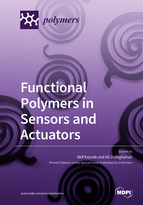Functional Polymers in Sensors and Actuators: Fabrication and Analysis
A special issue of Polymers (ISSN 2073-4360). This special issue belongs to the section "Polymer Applications".
Deadline for manuscript submissions: closed (30 April 2020) | Viewed by 47677
Special Issue Editors
Interests: conducting polymers; sensors; actuators
Special Issues, Collections and Topics in MDPI journals
Interests: 3D printing; 4D printing; soft actuators; robotic materials; soft machines
Special Issues, Collections and Topics in MDPI journals
Special Issue Information
Dear Colleagues,
Functional polymers show unique physical and chemical properties, which can manifest as dynamic responses to external stimuli such as radiation, temperature, chemical reaction, external force, magnetic and electric fields. Recent advances in the fabrication techniques have enabled the production of different types of polymer sensors and actuators that can be utilized in a wide range of potential applications in smart structures and systems.
This Special Issue aims to focus on the recent advancements in the modeling and analysis of functional polymer systems and will consider relevant research papers and review articles for publication.
Dr. Akif Kaynak
Dr. Ali Zolfagharian
Guest Editors
Manuscript Submission Information
Manuscripts should be submitted online at www.mdpi.com by registering and logging in to this website. Once you are registered, click here to go to the submission form. Manuscripts can be submitted until the deadline. All submissions that pass pre-check are peer-reviewed. Accepted papers will be published continuously in the journal (as soon as accepted) and will be listed together on the special issue website. Research articles, review articles as well as short communications are invited. For planned papers, a title and short abstract (about 100 words) can be sent to the Editorial Office for announcement on this website.
Submitted manuscripts should not have been published previously, nor be under consideration for publication elsewhere (except conference proceedings papers). All manuscripts are thoroughly refereed through a single-blind peer-review process. A guide for authors and other relevant information for submission of manuscripts is available on the Instructions for Authors page. Polymers is an international peer-reviewed open access semimonthly journal published by MDPI.
Please visit the Instructions for Authors page before submitting a manuscript. The Article Processing Charge (APC) for publication in this open access journal is 2700 CHF (Swiss Francs). Submitted papers should be well formatted and use good English. Authors may use MDPI's English editing service prior to publication or during author revisions.
Keywords
- 3D-printed polymer systems, structures, sensors, and actuators
- Modeling, analysis, and control of polymer systems, sensors, and actuators
- Shape memory polymers, hydrogels, polyelectrolytes, elastomers, and silicones
- Ionic polymers, conductive polymers, batteries, and electrochemical transistors








